Since we do not have any art guidebook, which survived from the Late Second Temple period, we should approach the topic with caution. The Menorah was definitely an important as a symbol in the Jewish art and it does refer to the Temple; but the Menorah was also a symbol of Judaism and Jews in the ancient world. It is just as reasonable to find a Menorah decorating a place where a Jewish community gathers to learn their Scriptures. This does not necessitate that every single ornament on the stone ought to be linked the Jerusalem's Temple cult.
See Also: New Archaeological Data from The Great Revolt in Jerusalem Raise New Questions on Josephus
By David Gurevich
Post-Doctoral Fellow, Institute of Archaeology, Hebrew University of Jerusalem
Post-Doctoral Fellow, Department of Land of Israel Studies and Archaeology, Bar-Ilan University
August 2018
“I referred to this trend as the” "Da Vinci codification" of our culture”, stated recently Steven Fine, the Director of the Center for Israel Studies in the Yeshiva University, assessing the scholarly debate which developed around the famous Magdala Stone. Fine addressed his comments to the theories of the Hebrew University professor Rina Talgam, an archaeologist of the Kinneret Academic College, Mordechai Aviam, and a few notable scholars outside Israel. The story takes us to Migdal where a decorated stone was discovered in-situ in the 1st century CE synagogue (Fig. 1). It was argued that the artifact is a symbolic reproduction of the Second Temple in Jerusalem. Others speculated that the stone contains an abstract visual representation of the Divine. “This reception is part of a broader trend in the popular consumption of archaeology”, continued Fine his criticism, “from Indiana-Jones-like searches for the "Lost Ark", the "Secrets of the Dead Scrolls", and the "Jesus family tomb"”.[1] So what it is all about?
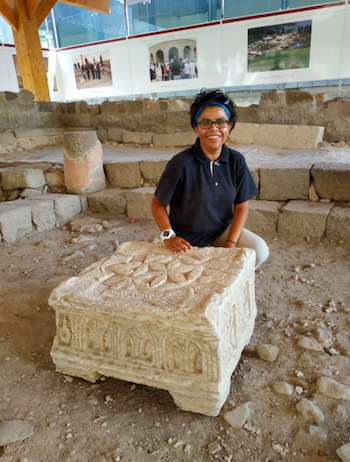
and Marcela Zapata-Meza, the
head of the Mexican Universidad
Anahuac expedition. Photograph
by the author, 2018.
A Brief of Migdal's History
Magdala antiquities are located on the west shore of the Sea of Galilee, several miles north of Tiberias, at the footsteps of Mt. Arbel. The remains are attributed to the town of Migdal, or Taricheae as it appears in the Greek-language sources (“tower” in Hebrew; the name “Magdala” constitutes its translation to Aramaic).
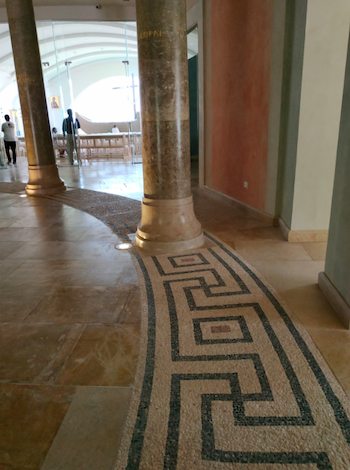
house Duc In Altum. Note the modern mosaic
floor that reproduces elements from the Magdala
synagogue mosaic. Photograph by the author,
2018.
The archaeological excavations were renewed there in 2009 as a salvage dig.[2] The church organization which owns the land, in cooperation with the Catholic Notre Dame Center in Jerusalem, planned to build a guest house for pilgrims. Israeli law requires an archaeological examination before carrying out an extensive development project. At this stage, neither the archaeologist nor the property owners could guess what mysteries Magdala would reveal. After the first seasons of the dig, the building plans had to be altered completely. The ancient remains were integrated into the new compound. In addition, an impressive modern prayer house was established, and the architects incorporated use of art motifs from the ancient site (Figs. 2–3). The project draws much attention. Today, in Jerusalem, visitors to the Notre Dame Center are shown an exhibition stand in the lobby entitled “Magdala—Walk Where Jesus Taught” that features photographs of the site and a donation box for the project.
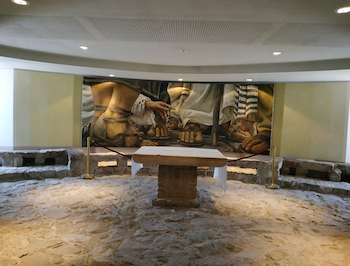
house Duc In Altum. The chapel was positioned
on top of 1st century port pavement. The interior
is modeled after Magdala's synagogue (note the
stone benches which reconstruct similar
benches discovered in the "vestibule room" of
the synagogue). Photograph by the author, 2018.
Archaeologically, Magdala was first settled during the Hasmonean rule. In this period, we witness a wave of settlement activity in Galilee. Settlers came from Judea, probably, in course of an organized enterprise by Jerusalem's authorities.[3] Magdala flourished in the Early Roman period. This fact correlates well with the literary sources (New Testament and Josephus).
The geographic area of northern Sea of Galilee served as fertile soil for Jesus' public ministry. The interest of the Christian organizations in Magdala is due to the famous character of the New Testament—Mary Magdalene, who probably originated from the town. However, the New Testament does not precisely mention that Jesus visited the town.
During the Great Revolt, Josephus provides an extensive description of the town in his narration. First, Josephus mentions the place in the list of the Galilean fortified strongholds (War 2.572). The town was a major center of rebel activity. Josephus testifies that Tericheae and Tiberias were incubators of radicalism in the region. The local groups often questioned his authority as a moderate commander of rebels in Galilee (War 2.595–613, 2.632–641). Eventually, Josephus successfully regained control over these two cities. In one of his military moves, he employed 230 fishermen boats from Tarichaea.
Even if the number of boats is exaggerated (as Josephus often did to impress his audience), this testifies both for the importance of the town as well as its lake-based economy. Migdal's ‘naval power’ did not overcome, of course, Vespasian's army:
“Vespasian, when his rafts were ready, put on board as many troops as he considered necessary to cope with the fugitives on the lake and launched his flotilla. The Jews, thus rounded up, could neither escape to land, where all were in arms against them, nor sustain a naval combat on equal terms. For their skiffs, being small and built for piracy, were no match for the rafts, and each was manned by no more than a handful of men who were afraid to close with the dense ranks of their Roman assailants... If they tried to break through the line, the Romans could reach them with their lances and transfixed numbers of them, or leaping upon the barks passed their swords through their bodies; sometimes the rafts closed in and caught their enemies between them, capturing men and vessels. When any who had been sunk rose to the surface, an arrow quickly reached or a raft overtook them; if in their despair they sought to board the enemy's fleet, the Romans cut off their heads or their hands… One could see the whole lake red with blood and covered with corpses, for not a man escaped.” (War 2.522–530; LCL, trans. H. Thackeray)
Judging by the above Josephus' report, it is not surprising that the new excavations, conducted by the Israel Antiquities Authority and the Universidad Anahuac in Mexico, exposed a wide quay along the shore. The dig in the town itself yielded paved streets, a marketplace, system of urban drainages, and residential quarters with several water installations identified as a unique-type of Jewish ritual baths (miqwa'ot).[4] However, the most fascinating finding is the synagogue and its odd stone.
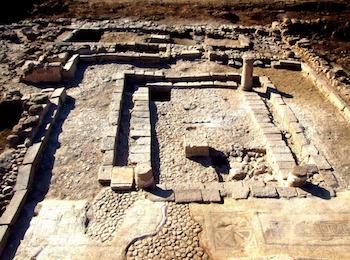
looking West. Photograph by the Magdala
Center, 2009. Courtesy Marcela Zapata-Meza.
The Imagination in the Temple-Time Synagogue
The importance of Magdala's synagogue is due to its dating: it was active in the 1st century CE until the Great Revolt, in other words, during the time that the Second Temple still existed. Despite the fact that surveys and excavations in Galilee and the Golan Heights revealed a fair number of ancient synagogues, the vast majority of them dates to later periods. A synagogue contemporaneous to the Temple is still a rare finding. Rachel Hachlili, in her Ancient Synagogues—Archaeology and Art (Brill, 2013), lists nine sites identified beyond doubt as synagogues from the Second Temple period.[5] The preservation of some is very partial.[6] Also, some of these structures operated only for a very short period, not more than a few years, such as the rebel's synagogue on Masada that functioned during the years of the Revolt. Hence, the excitement of the academic community discovering a new synagogue of a well-documented Jewish town, in a good state of preservation, is completely understandable.
What were the functions of synagogues when the Temple still existed? The communal prayers in synagogues were installed only after the Revolt by the Jewish sage Yohanan ben Zakkai. He was seeking a way to continue Judaism practices in the critical times when worshipping in the Temple could not be possible anymore. The earliest synagogues constituted probably ‘community centers’ — places where the congregation would gather to discuss daily issues as well as study the Scriptures together. The New Testament records that Jesus was reading from the scrolls and teaching his followers in various synagogues in Galilee (Luke 14:16–21; Matthew 4:23; Mark 1:21). This obviously testifies for the realia of a synagogue in his time.
The Magdala synagogue contained two large rooms. The main hall (“a reading room” as named by the excavators) has stone seats that surround the center (Fig. 4). A mosaic floor with rosette pattern survived in the eastern part of the room. The roof was probably supported by columns as fragments of basalt columns were discovered on site. The walls yielded remains of a colorful fresco with red, yellow, and blue geometric panels, and black and white frames. It is probable that the entire inner space was painted. This fact signals the wealthy status of Migdal's community.
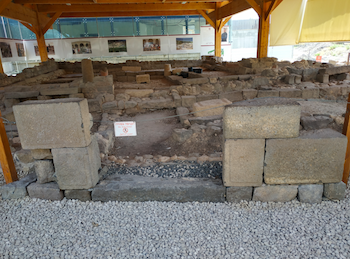
main entrance to Magdala's synagogue, looking
East. Photograph by the author, 2018
The first controversy of Magdala's synagogue meets us at the door. Literally. Today, visitors are shown an impressive doorway made of dressed ashlars (Fig. 5). Nevertheless, this doorway is completely a product of the scholarly imagination.
“One of the mysteries of the Magdala synagogue is the location of its main entrance, whose architectural elements were not discovered in context”, explains Marcela Zapata-Meza, the Head of the Mexican archaeological expedition to Magdala. “The IAA suggested that the main entrance was located on the west side of the building. They have reconstructed it there. An analysis of the synagogue's architecture, the archaeological drawings, and the first photos taken when the structure was excavated in 2009, leads us to the inevitable conclusion that the main entrance was located on the south, leading to the street”. Apparently, even not a single stone of the present entrance is on its place. Those have never existed there. How it can be? “The work of restoration involves interpretation, and may not always accurately represent the past exactly ‘as it was’.”, Marcela replies in a diplomatic manner.[7]
Interpretations, scholarly imaginations, and controversies are a prominent theme in the archaeology of Magdala today.
One Stone; Five Reliefs; Countless Sensations
A single particular artifact attracted the most-unusual attention of scholars. It is a middle-size decorated stone-block that was discovered in the central part of synagogue's main hall. Lawrence Schiffman, a notable professor of Jewish Studies at NYU, describes a conference that took place in Manhattan recently:
“The entire conference was about Magdala and its significance, and a model of the stone was provided to allow us a close-up chance to see what this strange object really was. We debated for days how to understand this artifact—a debate that is still raging among scholars.”[8]
This discovery is perceived so shocking that The New York Times, based on an interview with two Israeli professors, went out with a title (Dec 8, 2015) “A Carved Stone Block Upends Assumptions About Ancient Judaism”.[9]
The Magdala Stone has a rectangular-form (60×50 cm; and 40 cm high). Its base consists of four legs. Five of its sides are decorated with reliefs. On the stone's upper face, there is a rosette pattern, two palm trees and various plant elements. Another two rosettes with arches are found on a narrow (back?) face. The longer sides depict what may be seen as arched gateways, and an strange artifact that reminds a lamp.
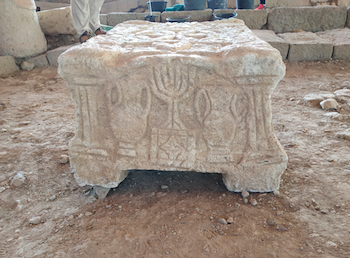
Stone (replica). Photograph by the author, 2018
The most interesting side of the stone has an extraordinary relief of a Menorah flanked with two amphorae and two columns (Fig. 6). It is a unique finding because Magdala Stone provides the earliest visual representation of the Menorah in synagogue art. Due to the dating, it is possible that the artist had witnessed the real candelabrum of the Temple.[10] Columns are found in later Jewish art (eg. the Bar Kochba coins[11]), where they are usually explained by scholars as an architectural façade that symbolized the entrance to the Temple. Hence, the appearance of the Menorah combined with the façade could not be random. The stone was found in-situ in a synagogue. Therefore, the academic race started on deciphering the stone. What could it be used for and what do its reliefs hide?
The excavators, Dina Avshalom-Gorni and Afran Najar of the IAA, suggested that the stone was used as a “prayer table”. However, it is puzzling how the low, 40 cm in height, stone could be convenient to serve as a table? Mordechai Aviam postulated that the stone was merely a base, on which the four-leg “reading Torah table” was fixed.[12] Aviam published a proposed reconstruction (Fig. 7), but because none of the components (except the stone-block) were found, his proposal remains largely hypothetical.
Rachel Hachlili proposed another idea: “It appears to have been used as an incense altar as the broken corners on the stone's face suggest”.[13] If so, it must be explained for what purpose was an incense altar kept inside a synagogue? How was the incense used? All these questions do not have a clear answer.
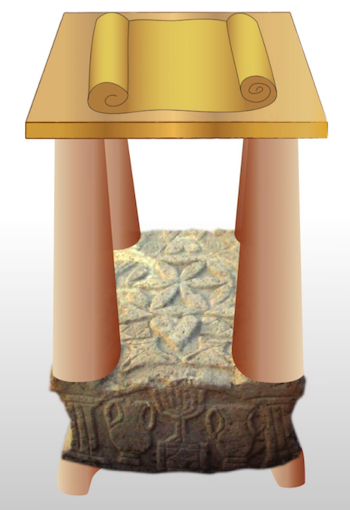
reading table by Mordechai Aviam. Drawing by
Dina Shalem. Courtesy M. Aviam.
Rina Talgam went even further. According to The New York Times, Talgam visited the site during the excavation and was completely stressed by the finding. She spent three hours looking on the stone! Finally, she resolved that the stone is a “three-dimensional depiction of the Temple of Herod, including its most sacred inner sanctum, known as the Holy of Holies”. The stone “might have been intended to give the space an aura of holiness "like a lesser Temple"”.[14]Talgam's suggestion was reiterated by the Tel-Aviv University professor Elhanan Reiner.[15]
Between the theoretical function as a reading table, an incense altar, and even a Temple-model that causes a ‘holy aura’, the debate has not produced definitive conclusions. But disagreements arose also on understanding the stone's reliefs.
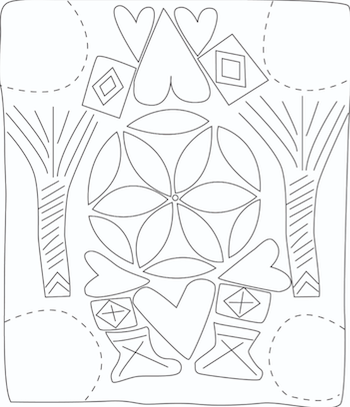
Drawing from the replica by Dina Shalem.
Courtesy Mordechai Aviam
Aviam argues that every motif has a symbology related to the Temple. For instance, he attributed the floral and geometric patterns on the upper face to the allegoric representation of the Twelve Loaves, which were placed on the Showbread Table in the Temple (Fig. 8). The ‘palm trees’ he regards as sacred shovels used in the work of sacrifice: “A deeper look at the drawing will show that the "trunk" of the "palm tree" is designed as a handle which is wrapped with a string to hold together a bunch of limbs”, suggested Aviam.[16] Further theories relate to the innocent-looking rosettes on the back side of the stone. The rosettes, which have a circular form, Aviam explains as ‘two wheels’ that stand for ‘the divine chariot’ (Fig. 9). In other words, these are not rosettes at all. Talgam developed this direction and combined it with the model-theory: the two wheels of the divine chariot could illustrate “the seat of God residing in the earthly Temple”.
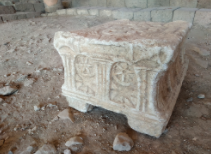
of the Magdala Stone
(replica) decorated with two
rosettes and arches.
Photograph by the author,
July 2018.
Are we witnessing an abstract art representation of the Divine power in a synagogue? If true, this would be an earthquake in our understanding of the Jewish spiritual world, since Jews in the Late Temple Period did everything to avoid using images of people or animals due to their religious restrictions.
Marcela Zapata-Meza sounds more skeptical. “The Magdala Stone is a unique piece of art, it has no comparison with any object from the 1st century”, she explained. “This makes the interpretation difficult. There are some elements that are easy to identify. However, I don't believe that all the carved elements in the stone should have a meaning. The question that I have no answer is: Why this amazing object is in the Magdala synagogue? ”[17]
Meanwhile, the ‘chariot-wheels theory’ produced a new bold interpretation in the research of the New Testament. “Is This Stone the Clue to Why Jesus Was Killed?”, wonders the title of a piece by Candida Moss, professor of Theology in the University of Birmingham.[18]Obviously, she implies that the answer is positive. Moss recalls the New Testament where the High Priest found Jesus committing blasphemy after Jesus proclaimed “you will see the Son of Man sitting at the right hand of the Mighty One and coming on the clouds of heaven" (Mark 14:62). The High Priest tore his clothes in sorrow. However, the formulation is puzzling: What was wrong with Jesus' answer? Moss believes that Jesus described himself sitting in the Divine chariot-throne, and thus proclaiming himself being God. And here, the Magdala Stone, is the missing evidence that everybody has been looking for — that already in the 1st century CE Jews employed the symbolism of the Divine chariot. Jesus' statement was understood by the Council as blasphemy, and Moss concluded that the mystery of Jesus' verdict might be now solved thanks to the Magdala Stone's rosettes!
Discussion
All the above-mentioned theories, as well as other analyses of the Magdala Stone, attempt to explain the symbolism in ancient Jewish art. Since we do not have any art guidebook, which survived from the Late Second Temple period, we should approach the topic with caution.
The Menorah was definitely an important as a symbol in the Jewish art and it does refer to the Temple; but the Menorah was also a symbol of Judaism and Jews in the ancient world. It is just as reasonable to find a Menorah decorating a place where a Jewish community gathers to learn their Scriptures. This does not necessitate that every single ornament on the stone ought to be linked the Jerusalem's Temple cult.
The Magdala Stone had an important function in the daily routine of the synagogue. This function is still uncertain. Being in the spotlight of synagogue's attendees, the stone had to be decorated to distinguish it from other artifacts in the main hall.
A well-known principle in the philosophy of science is Occam's Razor. The principle demands to prefer the simplest among a few possible explanations of a certain phenomenon. Perhaps, the best way to understand Magdala Stone's relief is to focus on the cultural context rather than attempting to decipher concealed meanings. Referring to rosettes, Steven Fine argued “I do not ascribe any special "meaning" to this common and simple visual motif other than its ability to fill large area with a unifying pattern that was easily fabricated”[19]. I tend to agree with Fine, keeping in mind that rosettes appear on the mosaic floor in the same synagogue but also in a few notable secular-nature institutions such as Herod's Western Palace in Masada[20] and on the floors of private bath-complex in the Upper City of Jerusalem.[21] Similar 'simpler' explanations should be prioritized when discussing the arcades and floral elements.
Following the trauma of the Seleucid rule and after the Hasmonean revolt, the Jewish society was even more eager to avoid any figurative representations in its art. This state of things constituted a challenge because people, naturally, wished to have items in their daily life decorated: e.g. floors, walls, and even ossuaries. This resulted in an extensive use of simple ornaments and geometric shapes. A good example is the fresco fragment in the Magdala synagogue with geometric color bars. Similar style frescos decorated private houses in Jerusalem. Colorful frescoes painted walls of houses in the Roman realm, but in the Jewish society an adaptation was required that would allow to keep the Second Commandment. Therefore, these frescos avoid depicting any living creature or person. This is the cultural context that we should keep in mind.
In Rachmani's famous catalogue of Jewish ossuaries, the rosettes and various floral patterns appear on a vast majority of the bone-boxes.[22] Many ossuaries had two ‘wheel-shaped’ rosettes that look-alike the rosettes of the Magdala Stone. Could it be that the bones of every deceased Jew were collected into a container that ancient people perceived as a model of Temple's Holy of Holies? In my view, it is doubtful
Nevertheless, it is excellent that new theories are being developed. Scholars write new articles. Publishers publish new manuscripts. The academic community reads and discusses. By asking new questions and working out new explanations, the science is advancing in its goal of better understanding the daily life in the 1st century CE. As long as these theories stimulate critical thinking we should commend them. However, making solid changes on-site based on a disputed interpretation is far more problematic. Visitors to the Migdal Synagogue today, who witness the newly built ‘ancient’ entrance, are not aware that this entrance is not authentic. Tour guides explain that through the doorway the synagogue was accessed, without even being aware that nothing of the entrance they see was found in-situ. This reconstruction may deceive even academics. At the least, a clear mark should have been set to distinguish the reconstructed part from the ancient remains that would signal of its modern origin. The present reconstruction constitutes a serious ethical challenge. Such a misrepresentation should have been avoided.
Conclusion
Magdala is a site in a process of development. The archaeological excavations are still going on. The Mexican expedition is planning to expand their work in the next years. They hope to expose the public areas spanned between the synagogue and the residential quarters of the town. This unique 1st century synagogue, with frescos and the depiction of the Menorah, already contributed much to our understanding of the Second Temple Judaism. The Menorah's image demonstrates that people attributed religious significance to synagogues in this period. But more important, the findings enable us to understand better the composition of the earlier synagogue interior. Where did the attendees seat? Where was the focal point in the activity inside the synagogue's hall? Were the walls of the first synagogues decorated? How did the real Menorah look like? And even, how many people a synagogue's hall could host? These questions are no less vital than the holistic symbology, if such had been ever given to, the stone's reliefs.[23]
Notes
[1] Fine, S., 2017, "From Synagogue Furnishing to Media Event: The Magdala Ashlar", Ars Judaica 13: 27–38.
[2] Avshalom-Gorni, D. and Najar, A., 2013, "Migdal", Hadashot Arkheologiyot: Excavations and Surveys in Israel 125, accessed July 26, 2018, http://www.hadashot-esi.org.il/report_detail_eng.aspx?id=2304; Zapata-Meza, M., Garza-DiazBarriga, A., and Sanz-Rincon, R., 2018, "The Magdala Archaeological Project (2010–2012): A Preliminary Report of the Excavations at Migdal", ‘Atiqot 90:83–126.
[3] The question of the emergence of the Jewish communities in Galilee in the late 2ndcentury BCE is being explored today in works on various sites in the region. For summary and references see: Leibner, U., 2012, "The Origins of Jewish Settlement in the Galilee in the Second Temple Period: Historical Sources and Archaeological Data", Zion 77, 437–469 (Hebrew; English summary).
[4] The water installations in Magdala were identified as miqwa'ot by Ronny Reich and Marcela Zapata Meza. They differ from the typical miqwa'ot in the Land of Israel. Magdala's miqwa'ot were not plastered but used the high level of the groundwater. Till today, these installations constitute the only example of ritual baths identified on shores of the Kinneret lake. See: Reich, R. and Zapata-Meza, M., 2014, "A Preliminary Report on the Miqwa'ot of Migdal", Israel Exploration Journal 64: 63–71.
[5] Hachlili, R., 2013, Ancient Synagogues—Archaeology and Art: New Discoveries and Current Research, Leiden.
[6] eg. the traces of the earliest synagogue in Capernaum.
[7] Marcela Zapata-Meza, personal communication with the author, July 2018.
[8] Schiffman, L., 2017, "The Magdala Stone", Ami Magazine (May 28, 2017), pp. 160–164.
[9] Kershner, I., 2015, "A Carved Stone Block Upends Assumptions About Ancient Judaism", The New York Times (Dec. 8, 2015), accessed July 26, 2018, https://www.nytimes.com/2015/12/09/world/middleeast/magdala-stone-israel-judaism.html
[10] Another interesting example of a contemporaneous to the Herod's Temple representation of a Menorah is a graffito discovered on a wall of a private mansion in the Upper City of Jerusalem. See: Avigad, N., 1980, Discovering Jerusalem, Jerusalem, p.147–149.
[11] eg. Meshorer, Y., 2001, A Treasury of Jewish Coins: From the Persian Period to Bar Kokhba, Jerusalem, pp. 143–145.
[12] Aviam, M., 2013, "The Decorated Stone from the Synagogue at Migdal: A Holistic Interpretation and a Glimpse into the Life of Galilean Jews at the Time of Jesus", Novum Testamentum 55:205–220.
[13] Hachlili did not completely reject the possibility that the stone was used as a base of a table. Hachlili (supra, note 5), Ancient Synagogues, p.41.
[14] According to information provided in The New York Times. See: Kershner,(supra, note 8), "Carved Stone". Talgam's research article is in preparation.
[15] Kershner,(supra, note 9), "Carved Stone".
[16] Aviam (supra, note 12), "The Decorated Stone", p.214.
[17] Marcela Zapata-Meza, personal communication with the author, July 2018.
[18] Moss, C., 2015, "Is This Stone the Clue to Why Jesus Was Killed?", Daily Beast (Dec. 13, 2015), accessed July 26, 2018, https://www.thedailybeast.com/is-this-stone-the-clue-to-why-jesus-was-killed
[19] Fine (supra, note 1), pp. 35–38.
[20] Interestingly enough, R. Talgam in her book dedicates a few pages discussing rosettes as decorations in the Jewish mosaics of the Late Second Temple period. See: Talgam, R., 2014, Mosaics of Faith: Floors of Pagans, Jews, Samaritans, Christians, and Muslims in the Holy Land, Jerusalem and University Park, PA. For the above-mentioned mosaic in the Western Palace in Masada see ibid, pp.11–13, Fig.10
[21] Avigad (supra, note 10), Discovering Jerusalem, p.104, 109.
[22] Rahmani, L.Y.,1994, A Catologue of Jewish Ossuaries in the Collections of the State of Israel, Jerusalem. According to Rahmani, "Rosettes are the principal ornamental motif used on the ossuaries" (ibid, p.39). See also Rachmani's discussion on motifs such as ‘Branches and Plants’, ‘Acanthus’, ‘Grape and Vine’, and ‘Palm Tree’ for floral elements (ibid, 39–49). Furthermore, for a very first impression, the author advises the readers to run image search on the Internet the with keywords ‘Jewish ossuary’.
[23] The author is grateful to Marcela Zapata-Meza, Andrea Garza-DiazBarriga, and Rose Sanz-Rincon for showing him the site and discussing the findings, and to Zvi Koenigsberg for his valuable suggestion. The author expresses his gratitude to Mordechai Aviam for the permission to use the drawings from his article.
Article Comments
Why are there flames coming…
Why are there flames coming off the Migdal stone's "rosettes" on the narrow side, when that is not case for the comparables mentioned?
"Could it be that the bones of every deceased Jew were collected into a container that ancient people perceived as a model of Temple's Holy of Holies?" Ask that question again in light of these two scriptural passages: Ezek 37.3 “And he said to me, ‘Son of man, can these bones live?”; 4 Macc. 18.17 “…affirmed the words of Ezekiel, ‘Can these dry bones live?’” Ossuaries came into use fairly closely in conjunction with Herodian Temple improvements - any architectural and iconographical additions from that time would be better known. The concurrent practice of "dry bones" collected in ossuaries after a year would reflect the eschatological belief in resurrection symbolized by the reanimation of bones (and in addition to that thought about the bones, notably the chariot is also featured in Ezekiel). By inscribing chariot wheels directly on the container of the dry bones, the dead was symbolically placing himself before the divine for judgement. There is nothing "Da Vinci Code-esque" about that postulation.
Finally, this fine-tuning of Aviam's original thesis is much more convincing IMO: Richard Bauckham, "Further Thoughts on the Migdal Synagogue Stone", Novum Testamentum, Vol. 57, Fasc. 2 (2015), pp. 113-135.
Thanks in advance for your consideration of these comments,
John
Please translate into…
Please translate into English what is written around Regina top of the Women’s Atrium.
Thank you

What a wonderfully informative article, thanks be to Dr. David Gurevich and all those upon whose shoulders he stands and all the living who also contributed.
Those “ Rosettes” on the stone, look to me to be very similar to the “Flower of life”
symbol which exist throughout ancient archeology and on stone deemed much older than the Magdala stones hypothetical date.
Also the two “palms” or “trees” could those be related to the garden of eden tail?
Six hearts, and four boxes which seem like Greek alchemical symbols for base elements.
Thank you for writing such a good article!
Jon W.